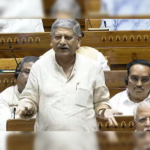By Subrata Majumder
Donald Trump’s thumping victory for USA Presidency for the second term unleashed a mixed bag of signal to India-USA relations. Unlike first term, rising global political tension due to Russia-Ukraine war and western sanctions on Russian have India’s situation a but different from the first term.
India has made a big challenge to USA in dealing with Russia despite sanctions and shifted its oil import dependency to Russia. This led to a new era of India –Russia economic relation, giving an edge for power balancing between the two super powers.
Russia emerged 6th largest trading partner of India in 2023-24, from 25th in 2021-22, while USA retained its stint as top trading partner of India. The climax between India-USA and India-Russia trade relations unveils that oil and oil based products emerged the major determinants. While oil based petroleum products are one of the major items of exports to USA, Russian oil has become pivot to manufacture oil based products, which are exported to USA.
In 2023-24, Russia accounted for 34.4 percent of India’s total crude oil import and oil based products accounted for 7.5 percent in total export to USA. Eventually, oil and oil based products will emerge crucial for India to engage both USA and Russia as important economic partners during Trump’s second period. Given oil is sensitive to inflation, high import tariff by Trump administration does not bode well for USA.
To this end, India’s relation with Russia will remain stable, notwithstanding USA’s pressure on India to abide by Russian sanction.
Donald Trump was assertive that he would impose 10 percent import tariff on all nations and 60 percent on China in his election campaign. He focused his America First policy , embarking on protectionism , with the end goal to benefit American workers and their families.
Nevertheless, during his first term (2017-21), counter measures to restrict imports from India, such as withdrawal of Special Status under GSP scheme (Generalized System of Preference) and imposition of high tariffs on steel and aluminium, could not instill weapon to dwarf exports from India. During this period, India’s exports to USA sustained unstoppable growth for the first 3 years. The growth trajectory continued during the successive period under the Presidentship of Biden, even though Biden administration did not relax tariffs. Eventually, USA continued to be remain biggest export destination for India.
How India could neutralized Trump’s protectionism in his first term? It lies with the composition of Indian export basket. Besides oil products, there are 3 other major products in the export basket. They are gems and jewellery (mainly diamond), drugs and pharmaceuticals and readymade garments and textiles. Together with petroleum products, these 4 products accounted for 43 percent of India’s export to USA in 2023-24.
One of the main reasons is that for most of these products, USA is import dependent, owing to lacklustre domestic manufacturing due to cost effectiveness and skill.
For example, India is currently 3rd biggest exporter of pharmaceutical products and 4th biggest exporter of readymade garments in USA market. In 2022, it accounted for 5.5 percent of total import of pharmaceutical products and in 2023, accounted for 7 percent in total import of readymade garments in USA market.
As regards drugs and pharmaceutical products, USA largely manufactures branded products that are highly profitable. For generic drugs, Americans rely on for standard prescriptions like antibiotic, which are predominantly sourced from developing nations where production costs are low.
Concerns are looming large in pharmaceutical and readymade garments industries in India with the Trump’s assertion for imposing 10 percent import.
Notwithstanding, there is a caveat. Given the fact that China is the biggest supplier of these two items in USA market and they will attract much higher import tariff than India, viz, 60 percent, it will give an edge to India to cut a pie in the share of Chinese products in USA market. To this end, higher import tariff on China will give a lease of life to Indian exporters to counter-balance the impact of 10 per cent hike in import tariff on India.
In addition, the instability of Bangladesh government will leverage more scope to Indian exporters for garment exports in USA market. Bangladesh is the 3rd biggest exporter of garment in USA market, sharing about 11 percent of import of garment.
Protectionism to immigration is another important threat of Trump’s America First policy. India is the biggest beneficiary of H 1B visa. Annually, more than 70 percent of H 1B visa is issued to Indians. In his first term, Trump immigration policy increased the denial rate for H 1B visa to 24 percent in 2018 and 21 percent in 2019.
Nevertheless, helped India in another way. Negated by restrictions on immigrants, US IT firms, who were more dependent on India for cost effective services, opened their branches in India for off-shore services.
As a result, USA investment soared in India during Trump period. It made a big leap from US$ 2.2 billion in 2017 to US$ 14.3 billion in 2020. The big IT and financial services companies, such as Intel and Morgan Stanley, made bulk investment in India. Currently, nearly 44 percent of US investment in India embraces computer software and hardware (mainly software).
In sum, India has got some cushion to deal with the Trumponomics during second term.. Indian policy makers have to calibrate the present policies to suit the exigencies of the situation. And ensure that maximum relief can be extracted from the policies. The challenge is there but Indian bureaucrats are mature enough to deal with that. (IPA Service)




 Will TDP Withdraw Support To The Modi Govt On The Issue Of Waqf Amendment Bill?
Will TDP Withdraw Support To The Modi Govt On The Issue Of Waqf Amendment Bill? 